As the vibrant hues of pansies grace gardens and containers, adding a burst of color to landscapes, it’s essential to understand the post-flowering care required to ensure their continued health and beauty. Pansies, known for their charming flowers, are resilient and versatile plants.
Assessing the Flowering Period: A Prelude to Post-Bloom Care
Before diving into post-flowering care, it’s crucial to understand the flowering period of pansies. Typically, pansies exhibit a prolonged blooming season, spanning from late winter to early summer. The duration of their flowering stage can vary depending on local climate conditions and specific cultivars. Observing the timeline of the flowers is essential, as it provides valuable insights into when post-flowering tasks should be initiated.
Deadheading for Prolonged Flowering Beauty
One of the primary tasks to undertake after pansies have finished flowering is deadheading. Deadheading involves the removal of spent or faded flowers, a practice that not only enhances the plant’s aesthetic appeal but also encourages continuous blooming. By promptly removing spent flowers, you redirect the plant’s energy from seed production back into promoting new flower growth. This meticulous practice is a simple yet effective way to extend the flowering period and keep your pansies in full bloom.
Fertilizing for Vigorous Growth
Post-flowering, pansies benefit significantly from a strategic fertilization regimen. Applying a balanced, water-soluble fertilizer with a formulation such as 10-10-10 or 14-14-14 provides essential nutrients for robust growth. The key elements—nitrogen (N), phosphorus (P), and potassium (K)—are crucial for stimulating healthy foliage, strong root development, and overall plant vigor. Fertilizing every 4-6 weeks during the growing season ensures that your pansies receive the necessary nutrients for continuous flowering and maintain their lush appearance.
Watering Wisdom: Maintaining Moisture Balance
Proper watering is paramount in the post-flowering care of pansies. While these flowers appreciate consistently moist soil, they are susceptible to root rot if waterlogged. Striking a balance between keeping the soil consistently moist and ensuring adequate drainage is key. Watering pansies in the morning allows the foliage to dry during the day, reducing the risk of diseases. Mulching around the plants helps retain soil moisture and regulates temperature, creating an optimal environment for post-flowering recovery.
Trimming and Pruning: Shaping Future Beauty
To encourage a compact and bushy growth habit, trimming and light pruning are essential post-flowering activities for pansies. Use clean, sharp scissors or pruning shears to trim back leggy or overgrown stems, promoting a more robust and aesthetically pleasing form. Aim to remove no more than one-third of the plant at a time, focusing on cutting just above a set of healthy leaves. This practice not only improves the overall appearance of the flowers but also stimulates lateral growth, ensuring a well-balanced and attractive display.
Division and Transplanting: Refreshing the Flower Beds
As pansies age, they may become crowded or develop a less vigorous growth habit. Dividing and transplanting established clumps is a rejuvenating technique that helps maintain the health and vitality of the plants. Ideally performed in early spring or fall, division involves carefully lifting the entire clump, separating the individual plants, and replanting them at an appropriate spacing. This practice not only refreshes the flower beds but also provides an opportunity to assess and amend the soil, ensuring optimal growing conditions for your pansies.
Comprehensive Pest and Disease Management
Pansies, like any other flowering plants, are susceptible to pests and diseases. Vigilant post-flowering care involves inspecting the plants regularly for signs of common issues such as aphids, snails, or fungal infections. A proactive approach to pest management includes using organic remedies like neem oil or insecticidal soap. For fungal diseases, such as powdery mildew, proper spacing, adequate air circulation, and the application of fungicides can help mitigate the risk. Addressing pest and disease issues promptly ensures that your pansies remain robust and resilient.
Overwintering Strategies: Preparing for the Cold Months
For those in colder climates, preparing pansies for winter is a crucial aspect of post-flowering care. Pansies are generally hardy plants, but some varieties may struggle in harsh winter conditions. Applying a layer of mulch around the base of the plants helps insulate the soil, protecting the roots from extreme temperature fluctuations. In regions with severe winters, you might consider covering pansies with frost cloth or burlap to shield them from the harshest elements. Adequate winter preparation ensures that your pansies emerge strong and healthy when the growing season resumes.
Seed Collection and Propagation: Sowing the Seeds of Future Beauty
Pansies produce seeds after flowering, and collecting them offers an opportunity for propagation. Allow some of the flowers to go to seed naturally, and once the seed pods have matured and dried, harvest the seeds. Store the seeds in a cool, dry place for future use or share them with fellow gardening enthusiasts. Propagating pansies from seeds allows you to cultivate new plants with the same charming characteristics as the parent flowers. This sustainable practice not only enhances your garden but also provides an opportunity to share the beauty of pansies with others.
Creative Containers: Adapting Pansies to Different Spaces
Pansies are renowned for their versatility, making them ideal candidates for container gardening. Post-flowering, consider repurposing pansies into decorative containers, hanging baskets, or window boxes. This adaptive approach allows you to enjoy the beauty of pansies in various spaces, whether it’s a sunny balcony, a shaded porch, or a compact urban garden. Choosing well-draining potting mix and providing adequate water and nutrients ensure that pansies continue to thrive in containers, offering a delightful display of color and charm.
Conclusion
In conclusion, the post-flowering care of pansies involves a thoughtful combination of horticultural practices aimed at sustaining their health and beauty. From deadheading for prolonged flowering to fertilizing for vigorous growth, and from division and transplanting to creative container gardening, each step contributes to the overall well-being of these delightful flowers. By embracing a comprehensive approach to care, you not only ensure the continued vibrancy of your pansies but also cultivate a garden filled with the enduring beauty of these resilient and charming blooms.


